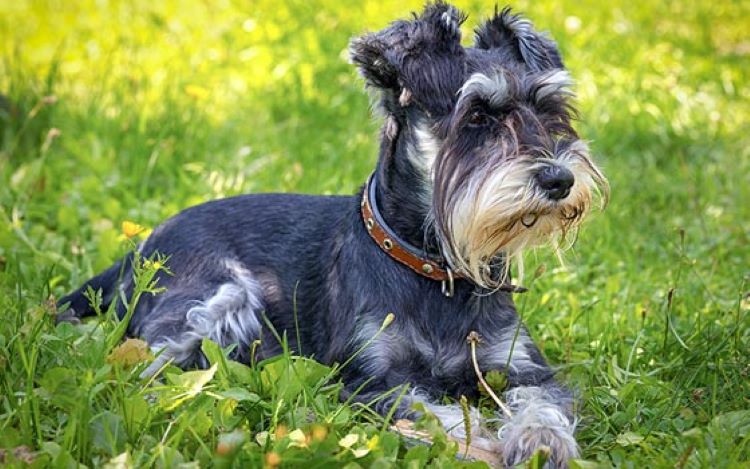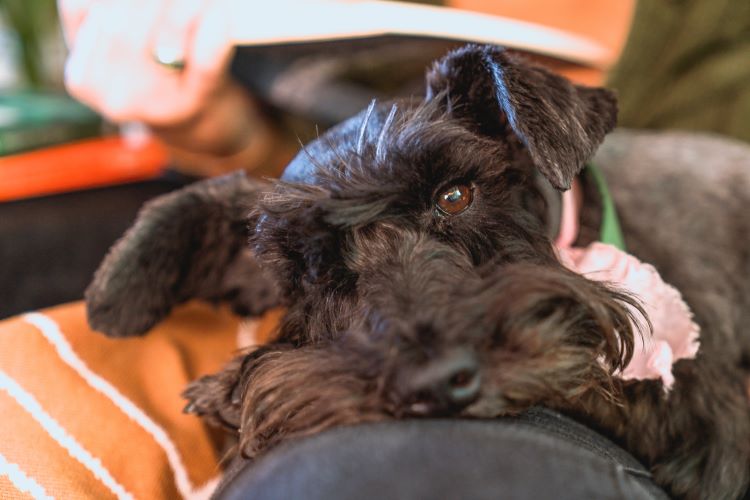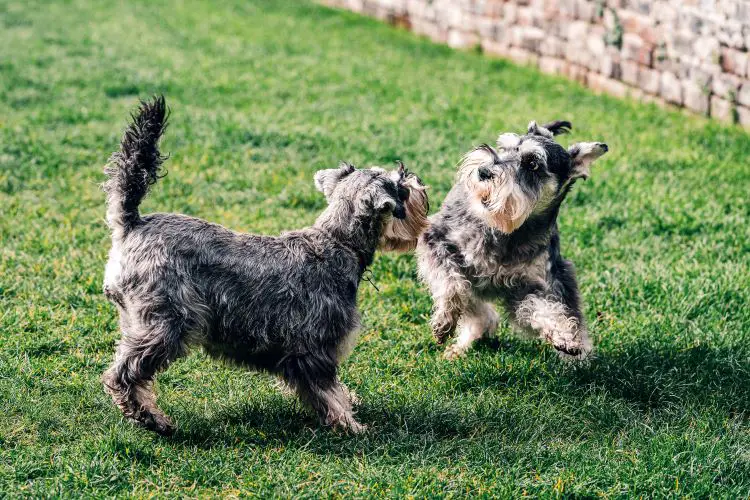Ready to help treat your pet to a healthy life?
Miniature Schnauzer Dog Breed Guide
By : Trupanion Staff | Updated Feb 18, 2024

A Miniature Schnauzer is a distinct breed within the Schnauzer family, which also includes the Standard Schnauzer and the Giant Schnauzer. But the Miniature Schnauzer stands out for being, well, quite small! In addition to its compact stature compared to its Schnauzer brethren, it is characterized by adorably bushy eyebrows, distinctive beard, and wiry double coat.
This pup has a rich history in the world of canines and fun temperament that endears them to many pet owners. Let's dive in with this comprehensive dog breed guide!
Miniature Schnauzer fun facts
- The name Schnauzer comes from the German word for snout or muzzle (Schnauze), highlighting the breed’s iconic square muzzle and a long beard.
- These lively pups reach an average height of 11 to 14 inches tall when fully grown, weighing between 10 and 18 pounds.
- While every other breed in the Terrier group has roots in the British Isles, the Miniature Schnauzer was developed exclusively on the European continent, so they have a different temperament and lack other physical traits that are seen in other terriers.
- Miniature Schnauzers have a double-coat, but they don’t shed much. Many allergy-sufferers find them to be a great choice for a pet, but take note — no dog is truly free of allergens. It’s important to spend time with a dog to determine any allergies to dander or saliva, as well as to their coat.
- Their best breed buddy is the German Shepherd. When the Miniature Schnauzer was used on farms to help herd and guard livestock, they worked in tandem with the German Shepherd, acting as a scout. Schnauzers have excellent hearing and would alert the larger guard dog to the threat.
- When used as ratters, the Schnauzer’s beard was often allowed to tangle and mat, so it formed a protective shield around the face, keeping biting rodents from exacting revenge.
- Miniature Schnauzers have been a favorite breed of many celebrities and public figures like Bruce Lee, Bob Dole, Doris Day, and even Usher.
History of the Miniature Schnauzer
The Miniature Schnauzer is a more petite version of its larger cousins, the Standard Schnauzer and the Giant Schnauzer. These larger versions were used in Germany for centuries before the emergence of the Miniature breed, typically for cart-pulling, herding, and livestock guarding. While the larger Schnauzers were depicted in German art as far back as 1492, it wasn’t until the late 1800s that the Miniature Schnauzer really made its debut. Breeders selectively bred the smallest of the standard size with breeds like the Affenpinscher, Poodle, or Miniature Pinscher to obtain the miniature-sized puppies. The first exhibition of Miniature Schnauzers was in 1899, and the breed quickly spread due to its versatility and temperament.
Changes over time
While not much has changed in the breed standard in the 120 years since the breed burst onto the scene, the cropping of Schnauzer puppies’ ears has fallen out of favor. The cropped ear is usually only seen in Schnauzers bred for the show, and the practice is becoming less common as the show standard now allows natural ears.
Miniature Schnauzers made their way across the Atlantic to the United States in the mid-1920s. Many American-bred Mini Schnauzers can trace their lineage back to one of the four imported from Germany in 1924. The American Kennel Club recognized the breed in 1926 and it has been a consistently popular breed, even cracking the top 3 at one point.

Get to know the Miniature Schnauzer
It's hard not to admire the Miniature Schnauzer's face once you see it. With its sage-like appearance, this pup has expressive eyebrows (often complete with long hair tufts) and a long, square beard. Of course, it's not all about appearances. The Miniature Schnauzer is a sweet and entertaining dog, with a spunky and opinionated personality. Whether it’s bouncing around or relaxing with their humans, they’re always willing to be the center of attention. They love their people fiercely and are eager to please, making them incredibly trainable. While mostly outgoing, they make excellent guard dogs because of their extraordinary hearing and willingness to announce someone’s approach.
While they’re a part of the Terrier group, the Miniature Schnauzer breed is the only terrier not developed somewhere on the British Isles. Instead, it was developed solely in Germany. As a breed, their temperament is often a bit gentler and more outgoing than the British, Scottish, and Irish terriers that were bred for their fiery tenacity and independence.
Similar breeds
- Standard Schnauzer
- Giant Schnauzer
- Affenpinscher
- Kerry Blue Terrier
- Brussels Griffon
- Border Terrier
Behavior and training
The Mini Schnauzer was bred as a versatile farm dog who could work in the fields, hunt vermin, and other pests, or act as a guard dog for livestock. Due to their continental lineage, they tend to have less intense training “drives” (tendencies for certain reactions to stimulus such as prey) and are less independent than the other breeds in the terrier group. Their compact bodies and agile movement made them excellent ratters during the 19th century, but their sociability and love for being with people helped them wiggle their way into more of a companion role.
Does this dog get along with others?
Miniature Schnauzers are usually outgoing when meeting new people, but they might act protective of their owner if they perceive a threat. Proper proactive exposure to new sights, sounds, people, dogs, and other animals as a young puppy is essential for their socialization skills.
This breed usually does well with children, especially older children that respect their space and don’t manhandle them. They just need to be properly socialized from puppyhood, and the children taught how to correctly interact with a dog. Young children and dogs should always be supervised, and it’s helpful for a dog to have their own “safe space” where they can go when they need some quiet time.
When it comes to animal buddies in the home, it’s once again all about socialization. As long as they have been properly socialized and introduced, Mini Schnauzers can enjoy and benefit from the companionship of other animals.
Exercise and mental enrichment needs
This lively breed needs lots of exercise to keep fit and trim — and burning excess energy helps prevent behaviors like excessive barking, digging, or destructive chewing. A couple of daily walks will do wonders, and if properly trained and conditioned for it, a Miniature Schnauzer can make an excellent jogging or running partner. They are quite playful, so playing games like fetch or tug-o-war is another excellent way to exercise a Schnauzer.
Mental enrichment is important for Miniature Schnauzers, which helps to keep them entertained and prevent unwanted behaviors. You can keep their brain sharp by teaching new tricks, attending obedience classes, joining a dog sport, and providing dog puzzles and interactive toys.
Miniature Schnauzers enjoy and excel in a variety of activities:
- Barn Hunt
- Earth Dog
- Small Dog Agility
- Rally Obedience
- Fly Ball
- Canine Freestyle
- Trick Training
- Nose work
Mini Schnauzer grooming and basic care
Miniature Schnauzers have a double coat that has a soft undercoat and a wiry outer layer. They are minimal shedders but do require regular grooming to keep the coat at a manageable length and free of mats and tangles. Miniature Schnauzers are seen in four different colors: salt and pepper, black and silver, black, and white. However, the American Kennel Club and Canadian Kennel Club do not recognize white as an acceptable color in Miniature Schnauzers, as this color was never seen in the Standard or Giant versions of the breed and might be a result of crossbreeding with other small breeds.
Miniature Schnauzers are easily recognized by those expressive eyebrows and their long, square beards. It’s the beards that need constant attention — if they are left unbrushed they will become matted quite quickly, although when this breed was used as a ratter during the 19th century its matted beard formed a protective shield against retaliating vermin.
If left to grow long, a Schnauzers wiry coat will grow two to four inches long and need daily brushing, but most owners prefer to keep the body clipped short (which gives it a soft and smooth feel), leaving a bit of a skirt and fuller-looking chest and legs to match the facial hair. You can also strip their coat, which is a more intensive all-over grooming technique where the dead fur is pulled by hand or with a stripping tool, although this is more often done on show dogs than pet Schnauzers. A Miniature Schnauzer should see a groomer every 5 to 8 weeks to keep their coat in tip-top shape.
Introducing your Schnauzer puppy to the grooming experience from a young age and in a positive way will make their lifelong grooming needs a breeze.

Miniature Schnauzers in pop culture
The Miniature Schnauzer has had quite a few famous human owners over the years:
- Simon Pegg (Actor)
- Liza Minnelli (Actress, Singer)
- Keyshia Cole (Singer)
- Sugar Ray Leonard (Boxer)
- Katherine Heigl (Actress)
- Janet Jackson (Singer)
- Mary Tyler Moore (Actress)
- Paul Newman and Joanne Woodward (Actor/Philanthropist, Actress)
- Dennis Basso (Designer)
- Avril Lavigne (Musician)
